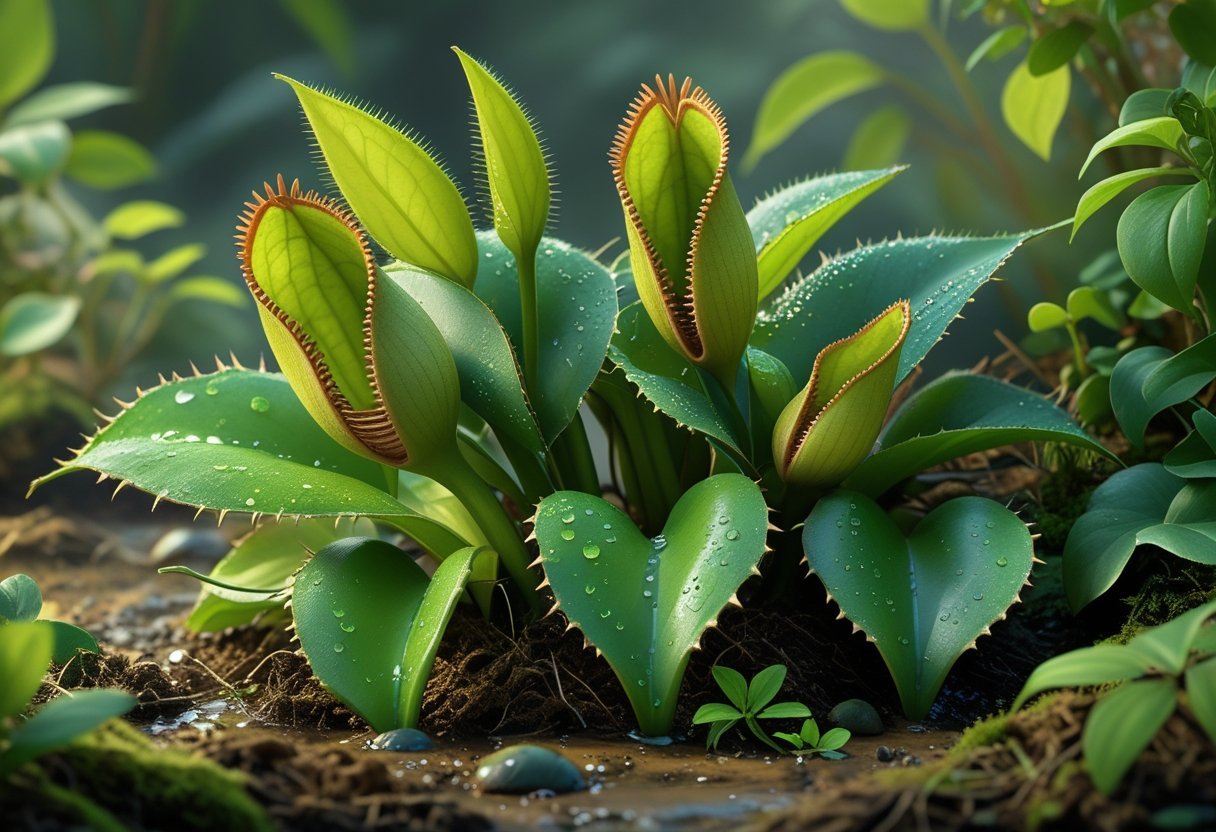Venus flytraps are some of the most captivating plants you’ll ever grow—seriously, who doesn’t love a plant that eats bugs? They might look a bit alien, but with the right setup, these carnivorous wonders can do just fine inside or outside your home. To keep Venus flytraps happy, you’ll want to give them loads of sunlight, keep their soil damp and acidic, and toss them a bug snack now and then.

These plants need a bit of a special touch—think soggy Carolina bogs. If you can get the water, soil, and light just right, you’ll have a healthy, weirdly beautiful plant to show off. It’s not rocket science, but they’re definitely not your average houseplant.
Key Takeways
- Venus flytraps need bright light and moist, acidic soil to grow well.
- Feeding them live insects periodically supports their health.
- They require a dormant period in winter for long-term survival.
Essential Requirements for Growing Venus Fly Traps
If you want a Venus flytrap that actually thrives, you’ll need to mimic its natural home as closely as possible. That means picking healthy plants, using the right pot, mixing up the right kind of soil, and getting a handle on watering and humidity.
Choosing Healthy Venus Fly Traps
A good Venus Fly Trap (Dionaea muscipula) should be a lively green, with a hint of red or pink inside the traps. The traps themselves ought to snap shut if you touch them—no limp or blackened traps, please.
Look for plants with several traps and some fresh new growth poking up. Skip any that look moldy, dried out, or just sad. Healthy roots are white and stringy. If you’re buying, stick with nurseries that know their stuff when it comes to carnivorous plants.
Selecting the Ideal Pot or Container
You’ll want a pot that drains well but still holds onto enough moisture. Plastic, glazed ceramic, or fiberglass are your best bets—terracotta can leach minerals into the soil, and that’s a no-go.
Go for a pot that’s shallow but wide, usually around 4 to 6 inches across. Avoid anything that holds water like a swamp, since soggy roots can rot. A tray underneath with a bit of standing water works wonders, keeping things boggy without going overboard.
Soil Mix and Substrate Selection
Venus flytraps are picky about soil—they want it poor and acidic, like their native bogs. The classic mix is 50% sphagnum peat moss and 50% silica sand or perlite. Don’t even think about using regular potting soil; it’s way too rich.
The peat moss keeps things acidic and damp, while sand or perlite adds air and helps with drainage. If you’re using sand, make sure it’s silica, not builder’s sand (which can have nasty minerals). Keep the soil damp, not drenched, or you’ll run into fungus and root problems.
Watering and Humidity Needs
These guys are pretty much allergic to minerals, so stick to distilled, reverse osmosis, or rainwater. Tap water’s usually loaded with stuff that’ll mess up their roots.
Keep the soil moist—think of a wrung-out sponge, not a swamp. I like to use a tray with an inch or so of water under the pot, just to keep the roots happy. Humidity around 50-70% is ideal. A sunny window or grow lights with some airflow works well. If the air gets too dry, you’ll notice the traps drooping or refusing to open.
Light, Feeding, and Seasonal Care
Getting the light, food, and seasonal rhythm right is what really keeps a Venus flytrap going. They’re not hard, but you do need to pay attention to the details—especially if you want those traps snapping shut.
Light Requirements and Sunlight Exposure
Venus flytraps love full, direct sun—at least 4 to 6 hours a day. That’s what keeps them strong, colorful, and ready for action. Indoors, a bright LED grow light can do the trick if you can’t give them enough natural sun, but don’t skimp on intensity or time.
If they’re not getting enough light, they’ll go pale and sluggish. Shady spots just won’t cut it. The more sun, the better, honestly. Unlike some other carnivorous plants (like sundews or butterworts, which are a bit more forgiving), flytraps really want that direct light.
Feeding Guidelines and Trigger Mechanism
Here’s the fun part: these plants use their traps—lined with those sensitive trigger hairs—to catch dinner. If a bug hits those hairs twice in quick succession, snap! Dinner is served.
Feed them bugs about a third the size of the trap—flies, crickets, ants, you name it. Don’t overdo it or toss in anything too big, or you’ll stress the plant out. If your plant isn’t catching bugs on its own (common indoors), just drop one in now and then.
And just a reminder: never use tap water, especially when feeding. Stick with distilled or rainwater to keep everything running smoothly. That’s not negotiable if you want happy, healthy traps.
Understanding Dormancy and Winter Care
Venus flytraps go through a winter dormancy period that lasts about 3-4 months, usually kicking in when the days get shorter and the temperature drops. You’ll notice the plant slows down, and a bunch of the traps might turn black and die off—which always looks a little alarming, but it’s totally normal.
If you’re caring for one, it’s important to back off on the watering. Just keep the soil barely moist; soggy roots are a recipe for trouble. No need to feed them either—honestly, they’re not interested.
Try to move your flytrap somewhere cooler for the winter, around 35-50°F (2-10°C), to mimic what they’d get outdoors. Oh, and if you’re growing sundews or butterworts, they don’t really do the dormancy thing the same way, so you’ll want to check their specific needs.




